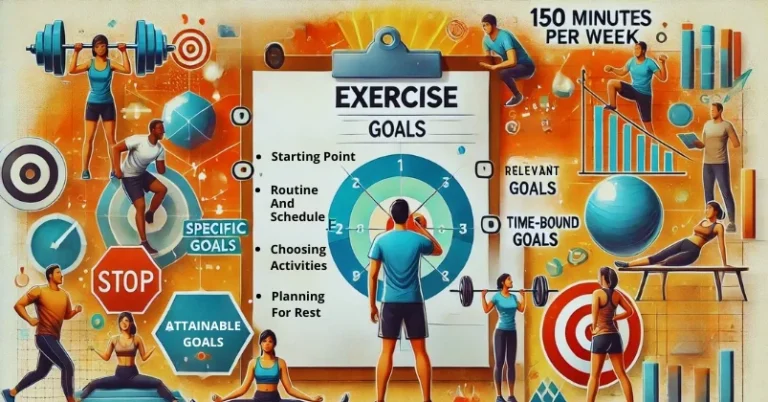Benefits of Exercise: Improve Your Health and Well-Being
Exercise is an essential component of a healthy lifestyle. Regular exercise can help improve physical health, prevent chronic diseases, and boost mental health. The benefits of exercise are numerous and extend beyond just physical health. However, despite the many benefits of exercise, many people need help to make it a regular part of their routine.
Physical benefits of exercise include improving cardiovascular health, strengthening muscles and bones, and maintaining a healthy weight. Exercise can also help reduce the risk of chronic diseases such as diabetes, heart disease, and cancer. Regular exercise can increase energy levels and improve sleep quality, making it easier to tackle daily tasks. Additionally, exercise can help reduce the risk of falls and improve balance in older adults.
Key Takeaways
- Exercise has numerous physical and mental health benefits.
- Regular exercise can help prevent chronic diseases and improve cardiovascular health.
- Different types of exercise offer unique benefits, and finding an exercise routine that works for you is important.
Physical Benefits Of Exercise
Regular physical activity has numerous benefits, including improvements in muscle and bone health, weight management, energy levels, sleep quality, and skin health.
Improvement In Muscle And Bone Health
Exercise helps to build and maintain strong muscles and bones. Resistance training, such as weightlifting, can help increase muscle mass and strength, while weight-bearing exercises like walking or running can help improve bone density. These benefits are especially important as we age, as they help to prevent muscle loss and reduce the risk of osteoporosis.
Aids In Weight Management
Exercise is an important tool for weight management. It can help to burn calories and increase metabolism, which can lead to weight loss. Additionally, exercise can help to maintain muscle mass while losing weight, which is important for overall health and preventing muscle loss.
Boosts Energy Levels
Physical activity can help to boost energy levels and reduce fatigue. Exercise increases blood flow and oxygen delivery to the body, which can help to improve energy levels and reduce feelings of tiredness.
Promotes Better Sleep
Regular exercise can help to promote better sleep quality. Physical activity has been shown to improve both the duration and quality of sleep, which can have numerous benefits for overall health and well-being.
Enhances Skin Health
Exercise can also have benefits for skin health. Physical activity can increase blood flow and oxygen delivery to the skin, which can help to improve skin health and appearance. Additionally, exercise can help to reduce inflammation, which is important for overall skin health.
In conclusion, regular physical activity has numerous physical benefits, including improvements in muscle and bone health, weight management, energy levels, sleep quality, and skin health. By incorporating exercise into our daily routines, we can improve our overall health and well-being.
Exercise And Chronic Diseases
Exercise is a crucial part of maintaining good health, and it can be especially helpful for people with chronic diseases. Here are some of the ways exercise can benefit those with chronic diseases:
Exercise And Heart diseases
Regular exercise can help improve heart health by reducing blood pressure and increasing cardiovascular fitness. Exercise can also improve insulin sensitivity, which can help prevent the development of type 2 diabetes.
Exercise and type 2 Diabetes
Exercise can help people with type 2 diabetes manage their blood sugar levels and improve their insulin resistance. Regular exercise can also help prevent the development of type 2 diabetes in people who are at risk.
Exercise And Cancer
Exercise may help reduce the risk of certain types of cancer, including breast, colon, and lung cancer. It can also improve the quality of life for cancer survivors by reducing fatigue and improving overall physical function.
Exercise And Obesity
Exercise can help people achieve and maintain a healthy weight, which can reduce the risk of many chronic diseases, including heart disease, type 2 diabetes, and cancer. It can also improve overall physical function and quality of life.
Exercise And Arthritis
Regular exercise can help reduce pain and stiffness associated with arthritis, as well as improve overall physical function. It can also help prevent the development of arthritis-related disabilities.
In conclusion, exercise can have numerous benefits for people with chronic diseases. By improving overall physical function and reducing the risk of many chronic diseases, exercise is an essential part of maintaining good health.
Mental Health Benefits Of Exercise
Regular exercise not only helps improve physical fitness but also has numerous mental health benefits. In this section, we will discuss how exercise can help reduce stress and anxiety, improve mood and mental health, and boost brain health and memory.
Reduces Stress And Anxiety
Exercise is an effective way to reduce stress and anxiety. When we exercise, our body releases endorphins, which are natural mood boosters. Exercise also reduces the level of stress hormones like cortisol and adrenaline in the body. According to a study published in the Journal of Clinical Psychiatry, regular exercise can be as effective as medication in treating depression and anxiety.
Improves Mood And Mental Health
Exercise has been shown to improve mood and overall mental health. It helps increase self-esteem, reduce symptoms of depression, and improve cognitive function. Exercise also helps in the production of norepinephrine, which is a neurotransmitter that plays a role in regulating mood.
Boosts Brain Health And Memory
Exercise has been linked to improved brain health and memory. It increases blood flow and oxygen to the brain, which helps in the growth of new brain cells. Exercise also helps in the production of brain-derived neurotrophic factor (BDNF), which is a protein that helps in the growth and survival of brain cells. According to a study published in the journal Neurology, regular exercise can help reduce the risk of dementia and Alzheimer's disease.
In conclusion, regular exercise has numerous mental health benefits. It reduces stress and anxiety, improves mood and mental health, and boosts brain health and memory. Incorporating exercise into your daily routine can help improve your overall well-being and lead to a healthier and happier life.
Different Types Of Exercise And Their Benefits
Regular physical activity is essential for maintaining good health. Different types of exercises offer unique benefits. Incorporating a variety of exercises into your routine can help you achieve maximum health benefits. Here are some of the different types of exercises and their benefits:
Benefits Of Aerobic Activity
Aerobic activity, also known as cardio, is any activity that increases your heart rate and breathing rate. Examples of aerobic activities include walking, running, cycling, swimming, and water aerobics. Aerobic activities offer numerous benefits, including:
- Improves cardiovascular health and reduces the risk of heart disease.
- Helps manage weight by burning calories and increasing metabolism.
- Reduces the risk of type 2 diabetes and improves blood sugar control.
- Boosts mood and reduces symptoms of depression and anxiety.
- Improves brain function and reduces the risk of cognitive decline.
Benefits Of Strength Training
Strength training, also known as resistance training, involves using weights or resistance bands to build muscle strength and endurance. Examples of strength training exercises include squats, lunges, push-ups, and weight lifting. Strength training offers numerous benefits, including:
- Builds muscle strength and endurance, which improves overall physical performance.
- Increases bone density and reduces the risk of osteoporosis.
- Helps manage weight by increasing metabolism and burning calories.
- Reduces the risk of injury by improving balance and stability.
- Improves overall quality of life by increasing strength and mobility.
Benefits Of Flexibility Exercises
Flexibility exercises, also known as stretching, involve stretching your muscles and joints to improve range of motion and flexibility. Examples of flexibility exercises include yoga, Pilates, and stretching exercises. Flexibility exercises offer numerous benefits, including:
- Improves range of motion and flexibility, which reduces the risk of injury.
- Reduces muscle tension and improves posture.
- Reduces stress and promotes relaxation.
- Improves overall physical performance by increasing mobility and coordination.
- Helps manage chronic pain and improves overall quality of life.
Incorporating different types of exercises into your routine can help you achieve maximum health benefits. Move more, sit less, and aim for at least 150 minutes of moderate-intensity aerobic activity and muscle-strengthening activities at least two days per week.
Exercise And Lifestyle
Regular exercise is an important part of a healthy lifestyle. Incorporating exercise into daily life can have a positive impact on overall health and well-being. Motivation for regular exercise can be a challenge, but there are many ways to make it a part of your daily routine.
Incorporating Exercise Into Daily Life
Finding time for exercise can be difficult, but there are many ways to incorporate it into daily life. Some ideas include:
- Taking the stairs instead of the elevator
- Walking or biking to work instead of driving
- Doing household chores like gardening or cleaning
- Parking farther away from the store to get some extra steps in
- Taking a walk during lunch breaks
Incorporating exercise into daily life doesn't have to be complicated. Simple changes can make a big difference in overall health.
Motivation For Regular Exercise
Motivation is key to sticking with a regular exercise routine. Here are some tips for staying motivated:
- Set achievable goals and track progress
- Find a workout buddy for accountability and support
- Mix up workouts to avoid boredom
- Reward yourself for reaching milestones
- Remember that no pain, no gain is a myth – it's important to listen to your body and adjust workouts as needed.
It's important to find a form of exercise that is enjoyable and fits into your lifestyle. Whether it's swimming, dancing, or trying new workouts, there are many options to choose from.
During exercise, the body temperature rises, causing sweat. Sweating is the body's way of regulating body temperature. As a result, exercise can help improve energy levels and belly fat. However, it's important to adjust workouts to avoid injury and listen to the body's signals.
Conclusion
In conclusion, engaging in regular physical activity has a multitude of benefits for individuals of all ages. Physical exercise can reduce the risk of developing chronic diseases such as heart disease, stroke, and diabetes, and can also improve physical functioning, fitness, and overall quality of life. According to the CDC, individuals who engage in seven hours of physical activity a week decrease their chances of dying early by 40 percent (1).
Additionally, physical exercise has been shown to have positive effects on cognitive performance and psychological well-being. Studies have found that regular exercise can improve attention, learning, and memory (2). Exercise can also reduce stress and anxiety, improve mood, and reduce feelings of depression (3).
Furthermore, physical exercise can slow down the aging process and help individuals maintain their independence as they age. Exercise can improve balance, flexibility, and coordination, reducing the risk of falls and injuries (4).
Overall, incorporating physical activity into your daily routine is a simple and effective way to improve your health and well-being. Whether it's going for a walk or jogging, taking a fitness class, or participating in a team sport, there are many ways to make exercise a part of your life. By doing so, you can reap the benefits of physical activity and live a healthier, happier life.
FAQs
Regular exercise has numerous physical benefits, including improving cardiovascular health, increasing muscle strength and endurance, reducing the risk of chronic diseases such as diabetes, and maintaining a healthy weight. Exercise also helps to improve bone density and joint health, which is especially important as we age.
Exercise is also beneficial for mental health, as it can help reduce symptoms of depression and anxiety, improve mood, and increase overall feelings of well-being. This is due in part to the release of endorphins, which are natural mood boosters, during physical activity.
For beginners or those with physical limitations, low-impact exercises such as walking, swimming, cycling, and yoga can be great options. These exercises are gentle on the joints and can be easily modified to suit individual fitness levels.
In addition to the immediate physical and mental benefits, regular exercise can also have long-term benefits such as reducing the risk of chronic diseases, improving cognitive function, and increasing overall lifespan.
The frequency of exercise needed to see results can vary depending on individual goals and fitness levels. However, for general health and fitness, it is recommended to aim for at least 150 minutes of moderate-intensity exercise per week or 75 minutes of vigorous-intensity exercise per week.
Incorporating exercise into daily routines can be fun and easy. Some ideas include taking the stairs instead of the elevator, going for a walk during lunch breaks, doing household chores such as gardening or cleaning, or joining a recreational sports league.








